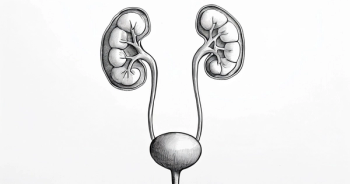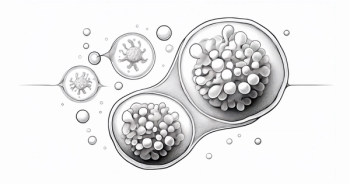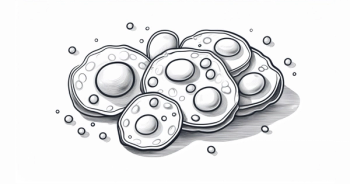
Case-Based Roundtable Meetings Spotlight
- Case-Based Roundtable Meetings Spotlight August 2021: Solid Tumors
Srinivas Evaluates 3 Novel Hormonal Agents for a Patient With nmCRPC
Sandy Srinivas, MD of Stanford Health Care, discussed the treatment of a 57-year-old Black man with nonmetastatic castration-resistant prostate cancer over the course of 4 years.
Sandy Srinivas, MD, a genitourinary oncologist, professor of Medicine, and Clinical Research group leader, in the Urologic Program at Stanford Health Care, discussed the treatment of a 57-year-old Black man with nonmetastatic castration-resistant prostate cancer (nmCRPC) over the course of 4 years.
How would you go about treating a patient such as this?
SRINIVAS: The National Comprehensive Cancer Network [NCCN] guidelines for patients who have conventional imaging studies that [are] negative for metastasis [show] we need to continue androgen deprivation therapy [ADT] and [manage the disease] based on the PSA doubling time.1 If the PSA doubling time is greater than 10 months, [we can] either observe the patient or give them secondary hormonal therapy, such as bicalutamide. For patients with a PSA doubling time of less than 10 months, [the NCCN recommends, in no particular order, 3 category 1] drugs, [namely apalutamide (Erleada), darolutamide (Nubeqa), and enzalutamide (Xtandi)], all of which are androgen receptor inhibitors.
What do findings of the SPARTAN trial [NCT01946204] tell us about apalutamide treatment for nmCRPC?
The SPARTAN trial looked at [over 1000] patients who had nmCRPC and a PSA doubling time of less than 10 months. The study also included patients with small pelvic lymph node [lesions] that extended to less than 2 cm below the iliac bifurcation [ie, N1 disease].2,3 Patients were randomized to either apalutamide or placebo; both groups were maintained on ADT. The [primary] end point of this trial was metastasis-free survival [MFS]. This trial was interesting because [patients who progressed to metastatic disease were allowed to start on physician-directed therapy, including open-label abiraterone acetate (Zytiga) plus prednisone]. So the trial design [enabled evaluation of further progression or death as a secondary end point among] patients who progressed on apalutamide or placebo and then received open-label abiraterone.4
Diving deeper [into the characteristics of patients in the SPARTAN trial], we see that three-quarters of patients had a PSA doubling time of less than 6 months, and 90% of patients didn’t receive any bone-targeting agents,2 which is the standard of care [in this patient group]. We [usually] use bone-modifying agents for patients who have metastatic CRPC, and I suspect that the 10% of patients who [received bone-modifying drugs in this trial] got it for osteoporosis. Most of the trial patients had prior therapy, [of that group], three-quarters of them [had received] a first-generation antiandrogen, such as bicalutamide.
The results of [the SPARTAN trial showed] a nice separation of curves [for the primary MFS end point]. The apalutamide arm had a median MFS of 40 months compared [with 16 months in the] placebo arm.2 [The findings corresponded to] an impressive hazard ratio of 0.28, which was statistically significant. [An analysis of trial follow-up, published] in 2020, showed that apalutamide improved OS [overall survival] compared with placebo.4 [This finding is not] surprising given that these novel hormonal agents, not apalutamide [per se], but other agents, have been shown to improve OS.
What adverse events (AEs) are associated with apalutamide?
[In general, novel hormonal agents are associated] with fatigue, [and in the SPARTAN trial, fatigue was more common in the apalutamide arm compared with the placebo arm].4 About one-third of patients in the apalutamide arm had hypertension, [including about 16% of patients who had] hypertension of grade 3 or 4. Diarrhea [was also more common in the apalutamide arm compared with the placebo arm], but falls, fatigue, and hypertension [are the most important AEs associated with apalutamide].5
One AE that is unique to apalutamide is rash, and we need to [counsel] our patients about this. About a quarter of patients [on apalutamide] get a rash, including about 5% [of patients who have a rash of] grade 3 or higher. The rash is usually macular or maculopapular, and onset usually occurs during the second and third month [of treatment]. The rash usually resolves [without systemic treatment], [but a] small fraction of patients require systemic corticosteroids. The rash reoccurs in about half of patients who are rechallenged [after suspending apalutamide treatment], results in dose interruption in one-third of patients, and [leads to] discontinuation of the drug in about 10% of patients.5
What do findings of the PROSPER trial tell us about enzalutamide treatment for nmCRPC?
Enzalutamide has been in [the prostate cancer] armamentarium for more than a decade. The PROSPER trial [NCT02003924], which has a design similar to that of the SPARTAN trial, [evaluated enzalutamide for treatment of nmCRPC].6,7 The trial enrolled 1400 patients who were nonmetastatic based on conventional imaging, had a PSA of greater than 2, [and had] a PSA doubling time of less than 10 months. Patients were randomized to receive either enzalutamide or placebo, and the trial’s primary end point was MFS. Patient characteristics [in the PROSPER trial] were similar to [those of] the SPARTAN trial. Three-quarters [of PROSPER trial patients] had a PSA doubling time of less than 6 months; the median PSA doubling time was [less than 4 months in] both arms of the study.7
The PROSPER trial evaluated MFS as the primary end point [and OS as a secondary end point],6,7 as was done in the SPARTAN trial. The median MFS was 22 months longer [among patients who received] enzalutamide compared with placebo, [corresponding to] a 71% [lower] risk of radiographic progression.7 At 48 months of follow-up, the enzalutamide arm had significantly better OS than the placebo arm [median survival in months, 67.0 vs 56.3; HR, 0.73].6 So we can now tell patients who are going on [enzalutamide] that the median OS is greater than 5 years.
What AEs are associated with enzalutamide?
Similar to apalutamide, [enzalutamide is associated with] hypertension of grade 3 or greater in about 5% of patients.7 Asthenia occurred in 1% [of patients who received enzalutamide and was more common in the enzalutamide arm compared with the placebo arm].
What do findings of the ARAMIS trial tell us about darolutamide treatment for nmCRPC?
The ARAMIS trial [(NCT02200614) evaluated one of the more recent novel hormonal therapies], darolutamide [Nubeqa].8,9 The trial enrolled close to 1500 patients who had a PSA doubling time of less than 10 months. Patients were randomized to darolutamide [or placebo]. Darolutamide, [unlike] apalutamide and enzalutamide [is taken twice daily]. The trial’s end points were MFS and OS, [respectively], as they were in the SPARTAN and PROSPER trials. Patient characteristics in the ARAMIS trial were also similar [to those of the other trials]; 70% of patients had a PSA doubling time of less than 6 months, and most had not received a bone-[targeting] drug,8 as is appropriate for this group of patients.
[ARAMIS] is the third trial showing that novel hormonal therapy improves MFS. Median MFS was 40 months [in the darolutamide arm], compared with 18 months in the placebo arm, [corresponding] to approximately a 60% reduction in the risk of metastases.8 [Darolutamide also significantly improved OS compared with placebo (HR, 0.69)].9 So all 3 drugs improve MFS and OS [in patients with nmCRPC].
What AEs are associated with darolutamide?
In the [ARAMIS trial], [6.6% of patients in the darolutamide arm experienced] hypertension, about 16% of patients experienced fatigue, [and about 4% of patients experienced falls].8 [But these and other AEs occurred at a similar frequency] in the darolutamide arm and placebo arm.
How do novel hormonal therapies for treatment of nmCRPC compare with one another?
Apalutamide, enzalutamide, and darolutamide [are all associated with similar improvements in MFS (range of HR for MFS, 0.28-0.41) and in OS (range of HR for OS, 0.69-0.78)].10
It’s difficult to compare these 3 drugs side-by-side, [in terms of AEs], but we tend to do that when we have similar drugs in the same space. Fatigue [seems to be more of concern with] enzalutamide [and apalutamide, occurring in about] a third of patients. Hypertension [also appears to occur more often with] both apalutamide and enzalutamide. Falls and fractures [occur less often] with darolutamide [than with the other 2 drugs]. People speculate [that this] may be because of darolutamide’s lipid-binding affinity, [which may result in] less central nervous system penetration for darolutamide compared with the other 2 drugs.
How will the use of conventional imaging to evaluate metastases fit into the paradigm of nmCRPC management in the future?
I think 18F-DCFPyL prostate-specific membrane [PSMA] PET scan is likely to become available to all of us by the end of the year. If we were to do [PSMA PET imaging of patients who are nonmetastatic by conventional imaging], maybe the nonmetastatic space would disappear as [many these patients would have] low-volume metastatic disease. In [patients with low-volume metastatic disease], we wouldn’t even [consider] PSA doubling time, rather we would just put them on a [novel hormonal agent]. [Thus far], we have had access to PSMA [PET imaging primarily] through research groups. However, I’ve been at meetings outside of the United States, where PSMA PET scans [are widely available], and [our colleagues have] just laughed at us; they have said [that] nmCRPC [no longer] exists because of PSMA PET imaging; patients have either oligometastatic disease or more [extensive] disease and, [therefore], automatically go on one of these [novel hormonal] drugs.
What is your takeaway from these trials?
These patients are [usually] asymptomatic with no evidence of metastases, so we have to weigh the remarkable [benefits of improved] MFS and OS [against the risk of] getting these AEs.
Overall, the conclusion [that we draw from these] 3 large trials is that early [treatment with novel hormonal therapies] results in meaningful improvements in MFS and OS for patients with nmCRPC. We now have 3 [novel hormonal] drugs approved for nmCRPC: Apalutamide, darolutamide, and enzalutamide, [which are] somewhat distinct from one another in their safety profiles.
REFERENCES:
- NCCN. Clinical Practice Guidelines in Oncology. Prostate cancer, version 2.2021. Accessed August 2, 2021. https://bit.ly/34xiIXZ
- Smith MR, Saad F, Chowdhury S, et al; SPARTAN Investigators. Apalutamide treatment and metastasis-free survival in prostate cancer. N Engl J Med. 2018;378(15):1408-1418. doi:10.1056/NEJMoa1715546
- Small EJ, Saad F, Chowdhury S, et al. Apalutamide and overall survival in nonmetastatic castration-resistant prostate cancer. Ann Oncol. 2019;30(11):1813-1820. doi:10.1093/annonc/mdz397
- Small EJ, Saad F, Chowdhury S, et al. Final survival results from SPARTAN, a phase III study of apalutamide (APA) versus placebo (PBO) in patients (pts) with nonmetastatic castration-resistant prostate cancer (nmCRPC). J Clin Oncol. 2020;38(suppl 15):5516. doi:10.1200/JCO.2020.38.15_suppl.5516
- Erleada. Prescribing information. Janssen; 2018. Accessed May 7, 2021. https://bit.ly/3hgrNvz
- Sternberg CN, Fizazi K, Saad F, et al; PROSPER Investigators. Enzalutamide and survival in nonmetastatic, castration-resistant prostate cancer. N Engl J Med. 2020;382(23):2197-2206. doi:10.1056/NEJMoa2003892
- Hussain M, Fizazi K, Saad F, et al. PROSPER: A phase 3, randomized, double-blind, placebo (PBO)-controlled study of enzalutamide (ENZA) in men with nonmetastatic castration-resistant prostate cancer (M0 CRPC). J Clin Oncol. 2018;36(suppl 6):3. doi:10.1200/JCO.2018.36.6_suppl.3
- Fizazi K, Shore N, Tammela TL, et al; ARAMIS Investigators. Darolutamide in nonmetastatic, castration-resistant prostate cancer. N Engl J Med. 2019;380(13):1235-1246. doi:10.1056/NEJMoa1815671
- Fizazi K, Shore N, Tammela TL, et al; ARAMIS Investigators. Nonmetastatic, castration-resistant prostate cancer and survival with darolutamide. N Engl J Med. 2020;383(11):1040-1049. doi:10.1056/NEJMoa2001342
- Gupta R, Sheng IY, Barata PC, Garcia JA. Non-metastatic castration-resistant prostate cancer: current status and future directions. Expert Rev Anticancer Ther. 2020;20(6):513-522. doi:10.1080/14737140.2020.1772759










































